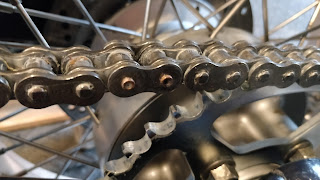It also has drop in pads that let me press new rivet chain connectors together.
The new vs. the old front sprocket. The new one is 19 teeth, the old one 18.
The new front sprocket on the motor. These are the parts I used:
RK 530 MAX-O O-Ring Chain Natural 114 $101.99
JT Steel Rear Sprocket 46T (530) JTR2010.46 $74.99
JT Steel Front Sprocket 19T (530) - JTF11 $80.19 (all prices CAD)
The '03 Tiger takes a 114 link chain, a 46 tooth rear sprocket and an 18 tooth front sprocket stock. I saw a suggestion online that going to a 19 tooth front sprocket calms down the bike a touch (it can be jumpy off the line) while also revving a touch slower while cruising which should improve mileage a bit.
I've had these on the bike since I got it over 30k ago. Still not in terrible shape. I've seen sprockets torn to shreds - some people must be very heavy handed on the controls to strip a socket like that. I've had the Tiger pulling the front wheel off the ground under acceleration so it's not like I'm soft with it (it's getting this drive train maintenance because the old chain had stretched in places). I'm curious to see and hear how the new parts work.
The many directions and warnings on the back of the chain box.
 |
| The Tiger had a deep maintenance last year, so this year it only needed the chain & sprockets. It's back under the blanket waiting for a break in the snow for a cheeky early-spring ride. Next up is doing the brakes on the Kawasaki, then I'm into rebuilding the Amal carbs on the 50 year old Bonneville winter project. |
If you're looking for torque settings and parts details for a 2003 Triumph Tiger 955i while doing a sprocket and chain, here they are:
- chain sag: 35-40mm
- drive chain adjuster (the clamp on the adjustable rings in the swingarm): 35Nm
- rear sprocket nuts: 85Nm
- front sprocket nut: 132Nm
- rear wheel axle bolt: 85Nm
- 530 chain with 114 links (if that seems confusing, check THIS out)
- 18 tooth front sprocket (though 19 is recommended)
- 46 tooth rear sprocket
















